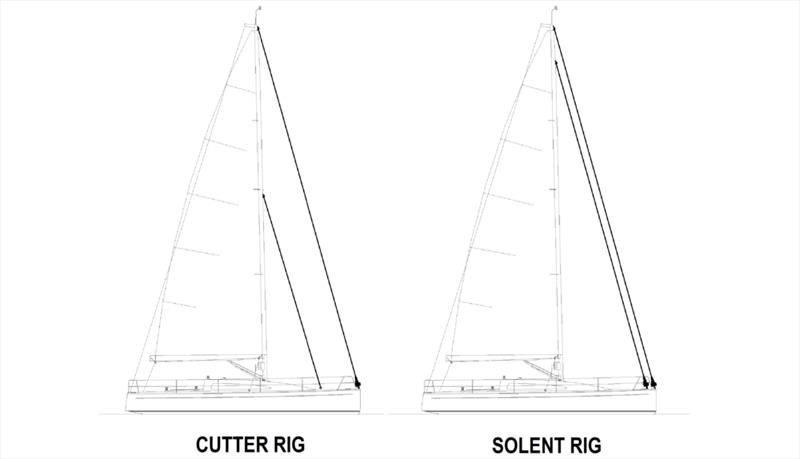
Bluewater Cruising: Cutter Rig versus Solent Rig - Part 2
by Kerri Robson, Upffront 20 Nov 2018 01:00 PST

Diagram showing the Cutter Rig versus the Solent Rig © Calanach Finlayson, Upffront.com
In a previous blog, Upffront evaluated the pros and cons of a cutter rig as a popular bluewater cruising set up. Now, it's the turn of the solent rig.
Like the cutter rig, the solent rig also utilises two headsails; the two different sized genoas sit close together, the second just behind the main forestay, unlike those on the cutter which sit relatively far apart.
So, how does a solent rig compare to a cutter rig?
Unlike the cutter rig, it is not intended for both headsails on a solent rig to be flown at the same time. That said, it is possible to use twin headsails (which help to steady the boat) to sail dead-downwind, with one sail poled out to starboard and the other to port. This is one of the major advantages of the solent rig. However, the downside of poled out twin headsails is that quick, emergency, changes of direction are problematic.
The solent rig does provide great scope for flexible headsail choices. You may have 2-3 sails in your existing wardrobe which could be recut by your sailmaker to give you more upwind / reaching flexibility across a range of wind conditions. You could explore different combinations of larger 150% genoas and smaller 100% jibs and, once setup, you have lots of options available to you, without the need for every going onto the foredeck.
However, despite its simplicity and ease of use, the solent rig is not as performance orientated as the cutter rig: when sailing close to the wind, the furled sail can interrupt the airflow over the sail that is being flown, reducing efficiency.
Without additional aft support, the forestay tension is shared between the two forestays, meaning the luff of both sails can fall away excessively upwind.In addition, there is no need for any additional backstays as the in-line stays are attached close to the masthead, which makes the solent rig a budget friendly option. The solent rig is thus – in theory – an easier retrofit: it requires just a solent stay attachment below the existing forestay, and a new halyard sheave. It is also common to use a 3:1 purchase system under the drum of the solent stay and make it a semi-removable system, to facilitate easier tacking of the main genoa, in light, upwind conditions.
Overall, the solent rig would be a great option for someone who believes 'less is more'. With two well-made headsails, in theory the rig should allow a sailor to go anywhere without ever venturing onto the foredeck... so, for short-handed, globe-trotting on a budget - and with plenty of time available - this could be an excellent option!
However, as you know, here at Upffront we are passionate about providing performance products and advice. If pressed to choose, we are a fan of the cutter rig together with the use of code zeros and asymmetric spinnakers, which we believe offers a complete, modern, bluewater cruising solution. It is often worth spending a little extra time and expense, to begin with, to get the best solution.
If you would like to talk to someone about your rig setup or a retrofit project, please feel free to contact upffront.com using our genoa reefing enquiry form!